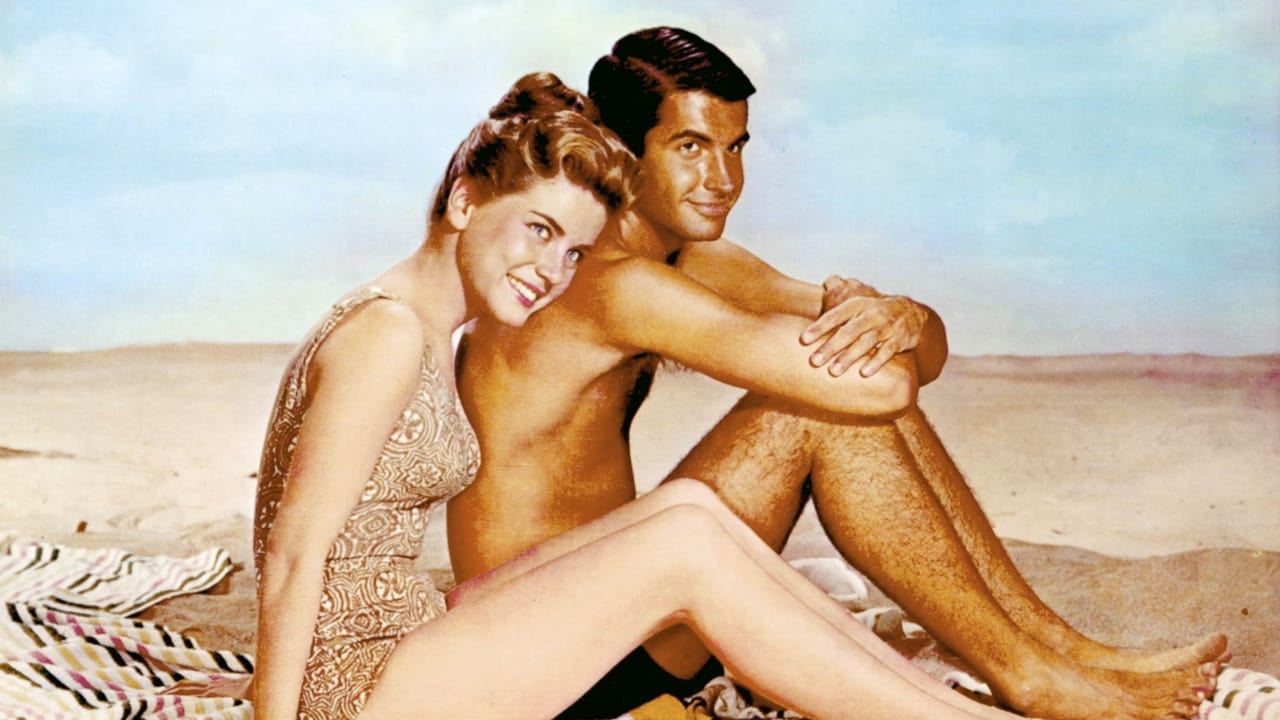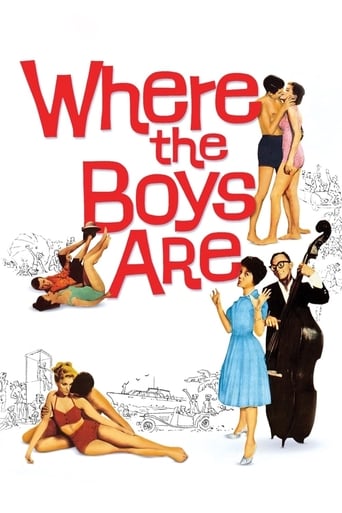

Beach movies were a popular genre in the late fifties and early sixties. Their main attraction was the chance to see lots of pretty girls (or, depending upon one's sex and/or sexual orientation) handsome boys in skimpy bathing costumes. As this was the era which saw the rise of rock- and-roll, catchy pop tunes were normally also featured. It is an interesting comment on changing social attitudes that the supposedly skimpy bathing costumes worn by the girls in such films are quite modest by modern standards, whereas those worn by the boys are actually more revealing than anything likely to be seen on a beach in 2014 when "board shorts" seem to be fast supplanting traditional swimming trunks. The "spring break" has long been a traditional rite of passage for American college students, and Fort Lauderdale, Florida, is a popular destination for such holidays; apparently it became even more popular after this film was released. (In 1960, and indeed during my own student days in the eighties, there was no equivalent British institution, but in recent years British students have taken to spending the Easter vacation in Cornwall or various Mediterranean resorts). "Where the Boys Are" tells the story of four girl students, Merritt, Melanie, Angela and Tuggle, who leave their university in the snowbound Midwest for a spring break in Fort Lauderdale with love and romance on their minds. (I presume that "Tuggle" is a nickname, although we never learn how she came by it or what her real name is). For most of its length the film sticks to the normal beach movie formula of sun, sea, sand, swimsuits, music and romantic comedy. It does, however, have ambitions to be something more than a standard teenage rom-com. It also attempts to explore the changes in attitudes towards sex and morality among the younger generation at the beginning of the decade which was to give us the expression "permissive society". The four girls have contrasting personalities and equally contrasting attitudes. Merritt, a self-confident, assertive young woman, believes strongly that premarital sex is something all young people should experience, and is brazen enough to express this shocking opinion in front of her prudish lecturer, the ironically misnamed Dr Raunch. There is, however a limit to Merritt's brazenness, a limit probably imposed by the strictures of the Production Code. She never actually uses the expression "having sex", still less its more vulgar synonyms, but prefers to rely upon coy euphemisms such as "making out" or "playing house". (This last, presumably an Americanism, would have surprised my grandmother who used to say "playing house" when she meant "playing bingo", one of her favourite pastimes).Tuggle is just as forthright as Merritt, but believes in saving herself for the right man. Angela is neurotic about her looks and frets that she will be unable to find a boyfriend- rather surprisingly, given that she is played by the very attractive Connie Francis, better known as a singer than as an actress, who also gets to sing the film's attractively melodious theme song. The shy, insecure Melanie takes Merritt's lecture to heart and resolves to lose her virginity as soon as possible. The film then traces the ways in which the girls' attitudes and expectations change during their stay in Fort Lauderdale. Merritt, the apostle of free love, undergoes a conversion when she falls for the good-looking, wealthy Ivy League undergrad Ryder and henceforth becomes an advocate of the doctrine that true love waits. (The actress who plays her, Dolores Hart, later underwent an even more radical conversion of her own, giving up her acting career to become a nun). Angela finds her own love-interest in the eccentric, wall-eyed jazz musician Basil, a boy who is as neurotic about his looks as she is (although in his case with greater justification) and frets about his inability to find a girlfriend. Tuggle is disillusioned when the boy she is interested in, "TV", abandons her for another woman, although as he is obviously a complete weirdo this is no great loss on her part. And Melanie? Well, this is where the film gets serious. The adventures of Merritt, Tuggle and Angela would fit firmly within the normal "beach party movie" tradition of rather silly romantic comedy with lots of fun, music and attractive youngsters of both sexes. The misadventures of Melanie would not. What actually happens to Melanie seems a bit vague as either their own puritan impulses or official censorship prevented the scriptwriters from spelling it out in too much detail, but it appears that she was sexually assaulted; her friends subsequently find her walking across the road in a distraught state and she is eventually taken to hospital after being hit by a car. This episode is only a brief one, but it makes for a jarring ending, something from a serious coming-of-age drama grafted onto a silly comedy. The filmmakers seem to have been aiming at two different markets, the teen audience who wanted to see a film about sex, as frank as the censors of the day would permit, and those members of the older generation who felt that if Hollywood was going to start making films about sex they should be hedged around with as many moralising "thou- shalt-nots" as possible. The resulting dog's dinner of a compromise makes "Where the Boys Are" one of those films that could only have been made during a very brief historical window. In 1940 or 1950 it would have been too sexually frank for the liking of the censors. By 1970, and certainly by 1980, its approach to its subject would have been so mealy-mouthed as to seem inadvertently comic. And today it serves as a historical record of what we might call the Not-Quite-Permissive Society of 1960. 4/10
... View MoreAt a Midwestern university, blizzard force winds knock pretty blonde Dolores Hart (as Merritt Andrews) off her feet. Warming up in class, random dating and premarital sex are college lecture topics of the day as Ms. Hart advises her teacher she intends to "play house before marriage." With copulating on their minds, Hart and three girlfriends decide to spend spring break in Fort Lauderdale, Florida. This is "Where the Boys Are" available. Joining Hart are extra tall Paula Prentiss (as Tuggle Carpenter), softly sexy Yvette Mimieux (as Melanie Tolman) and sweetly singing Connie Francis (as Angie). They pick up hitchhiker Jim Hutton (as "TV" Thompson) and find tanned George Hamilton (as Ryder Smith) on the beach...Like many thinly-produced 1960s films aimed at young audiences, this starts out mildly fun and slows to a sluggish pace. Controversial topics are present, but sanitized. The title song and others performed by Ms. Francis are much stronger on the original MGM recordings. The world's biggest female record star, Francis is inexplicably paired with impressionist Frank Gorshin (later famous as Batman's foe "The Riddler"). As you might expect, the attractive women end up teaching lucky viewers the difference between meaningless sex and true love. Highlights are the feature film debut performances by Francis and Ms. Prentiss, both impressing in roles that are otherwise lackluster. The men have little to do, with Mr. Hutton doing it best.**** Where the Boys Are (12/28/60) Henry Levin ~ Dolores Hart, Yvette Mimieux, Paula Prentiss, Connie Francis
... View MoreTo me, this is a coming of age movie. They go to Ft. Lauderdale as children and come home sadder but wiser adults. It's a journey.There is also the theme of the outsiders. Our core group are bookish or socially awkward/isolated who go to "where the boys are" and then aren't entirely sure what to do next because while they are full of theories, they are lacking in practical experience. These are not the social butterflies with easy ways and an unconcern about tomorrow who are all around them, casually flopping in their room and crowding every inch of the town. Melanie tragically found out that romantic delusions about Ivy League fellows have nothing to do with reality. In today's terms, she might be the innocent star struck girl who got involved with minor celebrities and all they were into. I hope she went home and gave a decent local boy she had never noticed before a chance.People read their own perspective on life into this movie. That's easy to do because it handles some adult themes and can't be classified as just another beach blanket bingo. It reminds me more of the original Gidget movie from 1959. It's about one crucial time when everything changed for those involved.And by the way, Tuggle sent the police after the rapist. He didn't get off scot free! And there was mention of a girl who got pregnant one vacation but she got married before she gave birth which was awkward but not horrifying, certainly not to these four who wanted love and commitment although they hoped no babies right away. So let's get over the idea that this is a typical "bad girl gets punished and nothing happens to the boy" movie. There was obviously a whole lot of mating going on as the booze flowed into underaged students in Ft. Lauderdale!But our group came from an unusually strait-laced background--nobody could call their college a party school! I enjoyed Tuggle so much. Paula Prentiss was an amazing find and I watch all of her movies I can. Tuggle was the modern assertive counterbalance to Melanie's almost Victorian vulnerability. She wasn't as emotionally constrained as Merritt, except when Merritt broke down and cried, or as passive and sort of sad as Angie. I could see why they would all be friends. They complemented each other. And I could see the nun that Dolores Hart would become in the portrayal of Merritt when she was tenderly listening to Melanie in the hospital.As for the main guys, TV was a stitch if juvenile, Ryder needed to put some age on him before he would be really handsome instead of a callow and shallow rich guy, the Ivy Leaguers were as interchangeable to us as they tried to be to Melanie, and Basil was purely weird--I most remember his myopic fish face in the tank!
... View MoreI was hysterical when Frank Gorshin fell into the fish tank followed by the rest of the gang. "Where The Boys Are" is one of the best movies of the sixties. Anyone who came of age at that time can definitely relate to the magical love Merritt found, the tragedy that Melanie experienced, the wanting to be loved and accepted as did Tuggle and Angie. The suave George Hamilton made many a young girls heart race faster. Girl crazy Jim Hutton with his style setting baseball hats and comedic personality was simply hilarious. The title song, one of my favorites still gives me chills. I have seen this movie countless times and I love the nostalgia it brings back each time. When it airs, enjoy it at least once. You will love it, I promise.
... View More